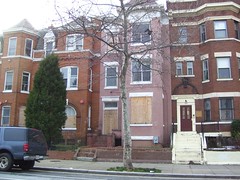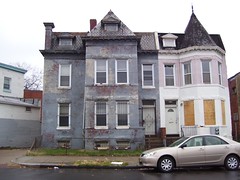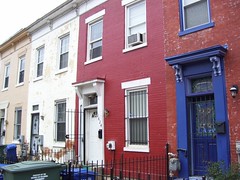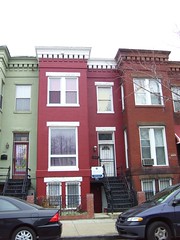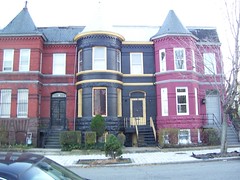I’m not sure which house is 34 Q. Actually, I’ve been flipping through my flickr collection and trying to match up houses for sale, and I really need to take more pictures…. and do a better job of taking the addresses.
From the description, I am guessing it is a short sale as the bank has to approve the price. But what you get for your $305,000 is a 10 bedroom 3 bath, 3500 sq ft vacant building with taxes high enough to make you cry if you keep it vacant. The price is a significant reduction from the $550K it started off as back in July of 2007. And the seller is taking a big hit as it was purchased in 2006 for $685K. *wince*
Tag: houses
1225 1st St NW for sale
Okay last house for sale of the day. I will post no more till, maybe Friday or next week. Red house is for sale. Red, not vacant house, is on the market for $599,900. It is a two unit building with a paying tenant in one unit. The other unit I guess could go to the new owner or be rented out as well. But honestly, I rather have owner occupiers. Not that there is anything wrong with renters. Sometimes renters become owners.
Nother 4th St house for sale
I need to find another street to hawk.
Anyway, vacant house 1721 4th St NW (the blue-gray one) is up for sale for the lovely price of $368,000. Apparently it is all historic being a two unit investment rental building, the way the developer intended it to be back in nineteen oh something. It’s also an historic mess needing some structural work done on it. Other houses on the block are assessed in the $400-500K range so you can be somewhat justified in the $100-$200K you’re going to have to sink into this thing to get it suitable for human habitation. Thankfully, this is not an HD so your rehab won’t be too costly or lengthy. Sadly, the backyard is just big enough for a lawn chair and a tiny toy-sized dog.
More houses on sale
1620 (the tan house on the far left) and 1624 (the red painted with white trim) 4th St NW are up for sale.
1620 is a foreclosure and is the cheapest at $275,000. Now you might be thinking “Wow, $275,000 what an affordable bargain.” Well I’ve been inside. Add $60-100K in repairs because that’s what you’ll need to make it decent. If you click on the full sized picture you might be able to see on the top right window, the bricks are doing something and look like they are about to pop out. Let’s say there are issues the house has that aren’t cosmetic. But neither are those things something that need to be addressed right now, but they need to be addressed in the next few years.
I’ve been inside 1624 too and I could have sworn it had AC, so I don’t know why there is a window unit in the top window. It is going for $390K. It’s not fancy. It’s got renters in it, so it is in a livable condition, unlike 1620. It’s okay looking and I’m not really sure what justifies that price. Of course it has only been on the market for 2 weeks.
Both 1620 and 1624 4th St have backyards big enough to fit a compact car in, and nothing else. Well maybe a Mini Cooper and a deck chair. Or enough of a rear yard to send the dog out back to do the doo when you’re too cold or too busy to take him out.
Both also have a one story kitchen attached to the main part of the house. Three houses further down the block have expanded, replacing the one story part to a two story, adding more square footage and look quite nice from the alley. So that is a possibility, more so with 1620 because of its price and its need for repair.
1631 4th ST NW for sale
I had a longer post on this but accidentally closed the window and lost it all. So a summary from what I remember: Not a foreclosure but a bank short sale. House is $415K, a down payment of 20% or 83K, would possibly make it $1,990 a month. Monthly RE taxes would be $315.00. There are renters in the house now and I have no idea of what a 3 bedroom 2 bath house rents for around these here parts to know if the house is actually a decent investment.
Yes, it is ugly
Prince of Pentworth has a more up to date picture and others are calling for the mighty hammer of HDs to come in and save the day. I say there is another way, but the problem is more than this one property. This is a unit block of ugly, historic ugly, plain ugly, and cheap modern fugly. Let’s start with the fugly shall we?
If I have identified the house right the place is 26 P St NE, owned by Payam Mobin of Hollowerind Court, Reston, VA. Mobin bought the property 11/17/05 for $363,000 and should have known better, but some people want to make things hard on themselves. Anyway, Mobin decided to throw an ugly monster pop up on the thin property. I can imagine a nicer looking pop-up but it would have been pointless because of all the other stuff to consider.
Next door is historically ugly. The two houses to the left of 26 P is 22 & 24 P, both burned out shells. Owned by DM McCoy (24 P) and the 22 P St LLC at 137 R ST SW. Nicely, both are being taxed at the vacant property rate, and their assessment seemed to have jumped up by 2X. Next to those shells is a ‘parking lot’, whose assessment for 2008 is about 5x what it was for 2007. Next to the parking lot are Refuge of Hope Disciple Center’s (Capitol Heights, MD) vacant lots, and those lots have not been taxed. No taxes apparently have been collected for 2007 for any of RoHDC’s properties on P. Zip. Nada. And they’ve owned those lots for over a decade. What’s up with that? How is it charitable, when there is no building to dispense the charity?
Next door to fugly is 28 P a vacant house owned by Sang Lee of Oakton, VA paying over $8K in taxes for 2007. On the end of the block, where P meets Florida, there is a gas station. Not terribly bad, not terribly pretty. There seems to be 3 households living on this unit block of P. Everything else is vacant or commercial or crap, or all three.
Going back to modern fugly, I looked at DCRA’s permit list but sadly, it is only for those issued in the past couple of months (OCT07-FEB08). Might actually have to walk up to the damned thing and see if the permit is valid. Heighwise, it may be a matter of right because the area is zoned to allow that high because it is a commercial area. Across the street from this is the DDOT parking lot. Conceviably, one could knock down the shells, the lots, and the monstrosity and build a decent looking 4-5 level building that complements the Peoples Drug Building that DDOT occupies. But this thing is so skinny and so badly designed that it is ugly.
So ugly I can’t imagine it being a sound investment, short of a halfway house. Then if, that, I’m sure it will go well nicely with whatever the Refuge of Hope might be planning.
Seriously, this side of the block would be better off razed, the three resident households compensated for their trouble and turned into a huge community garden. ‘Cause it’s just that F*ed up.
UPDATE:
Wrong about 3 households, make it 2. One household, 32 P St NE, owned by “HENRIETTA BERRIN” and taxed at the senior citizen rate of $0 for all of 2007 and $35.22 for 2005 is DEAD. Dead, dead, dead, dead. Deady-dead dead. Well according to the Social Security Death Index. Apparently she died May 20, 2005. Well, she’s now the second dead person paying taxes I know of, wait, no, she hasn’t paid taxes, ’cause she didn’t owe any. Ain’t DC Gov generous with the departed?
Landlord calls it quits?
A landlord who owns two houses on my street has recently put his houses up for sale. He originally bought the houses for $80K and $139K and is now listing them for $390K and $450K. I think that is a tad too much. Not only because it’ll make my assessment go up, but if anyone hasn’t heard there is a slow down in the RE market. Knock off about $50K from both of them to be somewhat ok.
Both places still have renters in them. There has been some gossip/rumor on the street that these are Section 8 houses. One house’s residents are pretty good, don’t make a lot of noise, not a lot of traffic going in or out, no people hanging in front, in essence they fit in. The other house, well they are much, much better now as opposed to when the residents first arrived.
So the $840,000 question is if the houses sell, will they remain rentals?
Let me throw in a pitch to encourage you to buy one of these houses (when the price gets lowered to something reasonable) so you can live on my block. One, we have a wonderful little block, where if you do stuff in your yard, you will totally make friends with your neighbors. If your interests include cycling, motorcycles, gardening, construction, or your toddler/baby, you will find friends. It’s not too hard to find a parking spot (but not super easy either). The lower priced house has some decent yard space, and a rear yard that, if you have no plans to grow anything back there, you could turn into a parking spot for a compact car.
People over things
This comes out of some email correspondence I had this week about an inquiry about a Shaw house’s history. Sometimes you can find the date of when something was built, sometimes not. The date on my lovely domicile is based on tax records, one year it’s taxed as land, next year land and an improvement, no permit, and zilch about a builder. However, my interest in structures, my own particularly, is based on maintenance and bases for complaints when it comes to maintenance and the inadequacies of the building.
I have a greater interest in flesh and blood than bricks and mortar. People do things, they go to work, they have families, they have relationships, they have a story, and the place where they live is absolutely uninteresting without them.
And the people I’m most interested in are the ones who lived around here. This is to differentiate from the landlords who most likely, didn’t. I’m picking up from some of you a thinking that the focus should be on the property owner. Maybe in other parts of the country, maybe the place where you came from, people built and bought homes to live in. Maybe they made their little plot, a family home, where at least one generation would remember it fondly as the place they grew up and a place to return. Not the case here. The owners were landlords, their family homes were elsewhere. In the case of the woman who once owned my house, it was just another investment, something that could be bought and sold and rented out for income.
From the 1880 to 1930 census stuff I’ve seen, there were a lot of renters in the neighborhood. And I’ve noticed these people moved around. I was trying to find out who was the earliest family to live at a certain TC house on the 1500 blk of 1st Street. I found the family living there a few years after the date the house was built, and when I went back through the city directory (arranged by name) to see if the house existed a previous year (and it would be confirmed by that family being there in those previous years), that family lived further up 1st in Eckington.
The fun question then becomes, why move around? Why stay in a place for only a few years only to move 1/4 mile somewhere else? Why can’t you stay in one spot? The building just sits there, and doesn’t generate a lot of questions for me. The building is the backdrop, the scenery, the stage, but the play is nothing without the performers.
I’ve rambled enough, but sometime later I want to return to the idea of what it means to be an area with a very restless renter population.
Townhouses of Truxton
I really don’t have much to blog about today as I am still recovering from the nasty cold that had me off of work for two days, couch bound and missing church this weekend.
If you haven’t noticed I’ve been adding to my Flickr set “Townhouses of Truxton” slowly but surely and it has been filling out quite nicely. I’ve got P-R Streets covered as well as Bates, 1st and 4th. I could stand to do more with Florida and New York Avenues and more of the Hanover (or any Hanover, I got no Hanover St) street area. My goal is to try to show the variety and similarity of the buildings from the late 20th Century Co-op that commands a nice chunk of upper Truxton to the early 20th Century mass produced investment housing (lest y’all start waxing romantic about Victorians), to the cramped 19th century Federals that by the Grace of G-d haven’t crumbled into dust.
There are over 120 photos in the set and I’ll add more as I get out early enough to take pictures when few people are milling about.
There are also pix of houses in the NE section of the TC. For most things I tend to cut Truxton off at North Cap, but for the fun of it, I’m adding the section that really isn’t in Eckington and has only a handful of houses.
403 R St NW

Well another vacant house for your viewing. This one is at 403 R Street NW, owned by Dorothy Farr of 57th Ave S, Seattle, WA, who got the property in 2003 and surprise there is no available data about a ‘sold for’ amount. But there is something interesting. This property has a Class 3 exception. Class 3 is the vacant property rate where one is charged $5 per $100 in house value. However, one can get an exemption by doing work on the property or having it up for sale. Because the government is way too smart to just take your word for it, you gotta go through the motions, and on the door of 403 R St there are building permits.
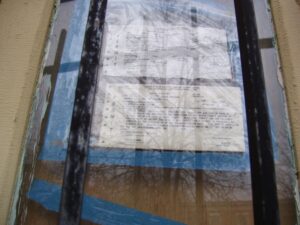 Yet, these date back to 2004, and from my observations, not much has happened since 2004, except the yard gets mowed. The windows are broken and the downstairs window is cinder blocked. The building is secure, but I don’t know if that requires a permit. And according to my permits the authorized work must start within one year of the date the permit was issued, or the permit expires. And if the permit is expired then someone shouldn’t be getting a Class 3 exception for construction. Maybe it’s for sale.
Yet, these date back to 2004, and from my observations, not much has happened since 2004, except the yard gets mowed. The windows are broken and the downstairs window is cinder blocked. The building is secure, but I don’t know if that requires a permit. And according to my permits the authorized work must start within one year of the date the permit was issued, or the permit expires. And if the permit is expired then someone shouldn’t be getting a Class 3 exception for construction. Maybe it’s for sale.

